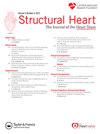经导管主动脉瓣置入术中严重主动脉狭窄患者心外膜脂肪组织增加与二尖瓣环钙化无关
IF 2.8
Q3 CARDIAC & CARDIOVASCULAR SYSTEMS
引用次数: 0
摘要
背景:二尖瓣环钙化(MAC)在老年人中很常见,且预后较差。假设MAC是一种不同形式的动脉粥样硬化。心外膜脂肪组织(EFT)与不同的心脏结构密切接触,在房室沟和房室瓣膜周围区域尤为明显。EFT的量与冠状动脉疾病的程度有关,包括斑块负荷和冠状动脉钙化。方法回顾性分析n = 543例(53.6%为女性)连续高级别主动脉瓣狭窄患者,在经导管主动脉瓣置入术前计算机断层扫描中评估EFT容量和MAC。比较无/轻度MAC和中度/重度MAC患者的EFT容量、基线、手术和术后特征。以MAC为因变量进行单变量和多变量回归分析。结果超过四分之一(n = 154, 28.4%)的患者有中度或重度MAC。中度/重度MAC患者与轻度或无MAC患者的EFT体积差异无统计学意义:130 (94-164)cm3 vs 133 (95-176) cm3;P = 0.704。因此,EFT容量不能预测MAC的增加。女性、房颤和是否植入过起搏器是中度/重度MAC的独立预测因素。结论EFT的增加不是MAC的预测因素,因此其不利的促炎特性似乎在MAC的发展中没有显著作用。本文章由计算机程序翻译,如有差异,请以英文原文为准。
Increased Amounts of Epicardial Fat Tissue Are Not Associated With Mitral Annular Calcification in Patients With Severe Aortic Stenosis Planned for Transcatheter Aortic Valve Implantation
Background
Mitral annular calcification (MAC) is a common finding in the elderly that is associated with worse outcomes. It is postulated that MAC is a different form of atherosclerosis. Epicardial fat tissue (EFT) is in close contact with different heart structures and is especially pronounced in the atrioventricular grooves and the area surrounding the atrioventricular valve apparatus. The amount of EFT is associated with the extent of coronary artery disease, including plaque burden and coronary calcification. The aim of this study was to investigate whether EFT is also associated with the extent of MAC.
Methods
In this retrospective analysis of n = 543 (53.6% female) consecutive patients with high-grade aortic stenosis, EFT volume and MAC were assessed in the pre-transcatheter aortic valve implantation computed tomography scans. Patients with no/mild MAC and moderate/severe MAC were compared in terms of EFT volume and baseline, procedural, and postprocedural characteristics. Univariate and multivariable regression analyses were performed with MAC as dependent variable.
Results
Over one-quarter (n = 154; 28.4%) of the patients had moderate or severe MAC. The EFT volume between those with moderate/severe MAC and those with little or no MAC did not differ significantly: 130 (interquartile range 94-164) cm3 vs. 133 (interquartile range 95-176) cm3; p = 0.704. Accordingly, EFT volume did not predict increased MAC. Female sex, atrial fibrillation, and prior pacemaker implantation were independent predictors of moderate/severe MAC.
Conclusions
Increased EFT is not a predictor of MAC, and thus its unfavorable proinflammatory properties do not seem to play a significant role in the development of MAC.
求助全文
通过发布文献求助,成功后即可免费获取论文全文。
去求助
来源期刊

Structural Heart
Medicine-Cardiology and Cardiovascular Medicine
CiteScore
1.60
自引率
0.00%
发文量
81
 求助内容:
求助内容: 应助结果提醒方式:
应助结果提醒方式:


